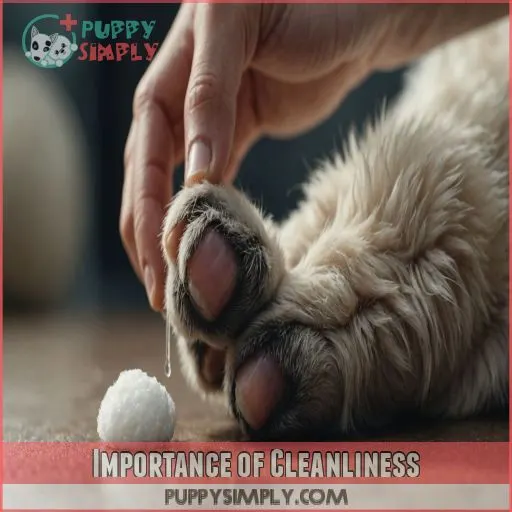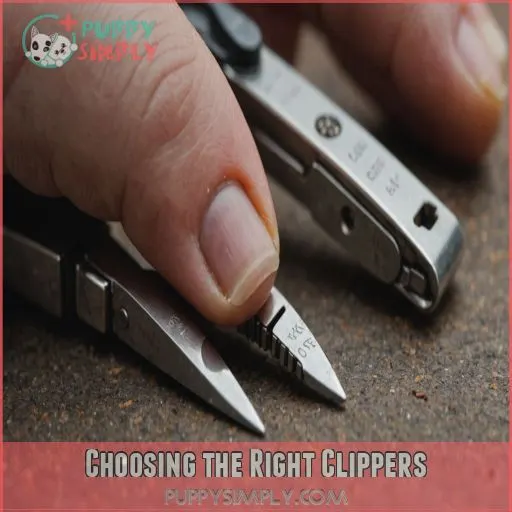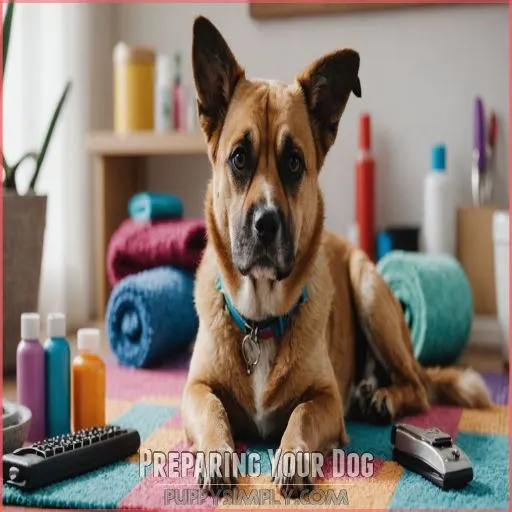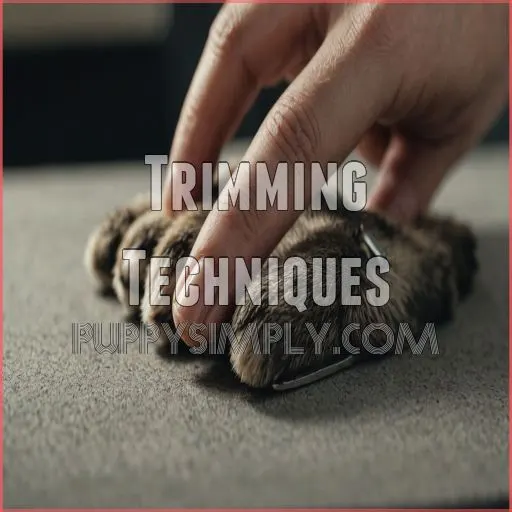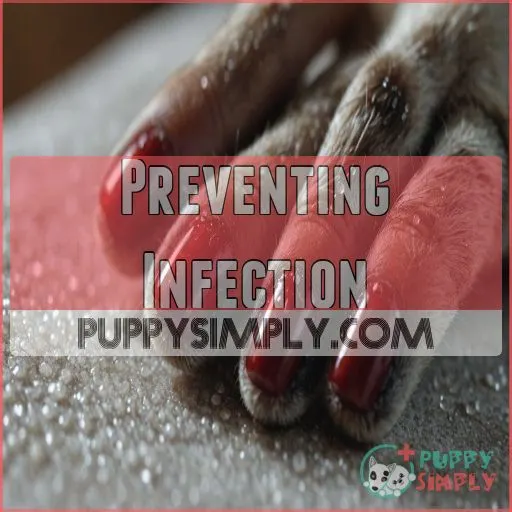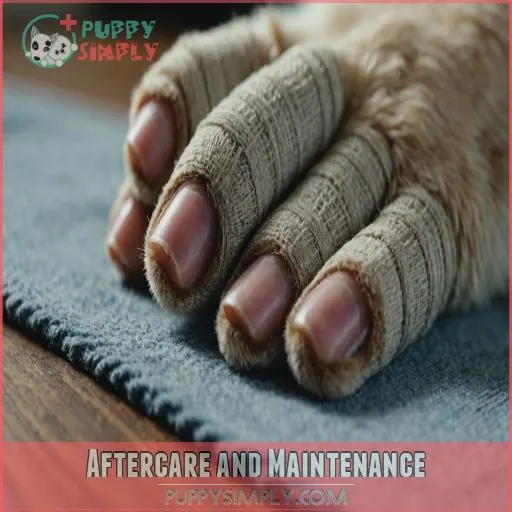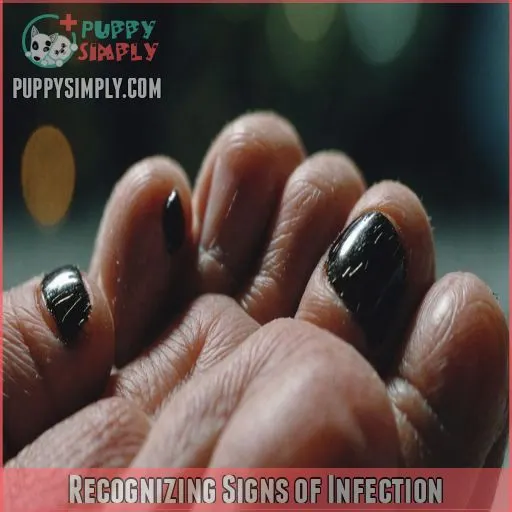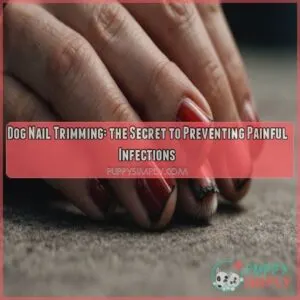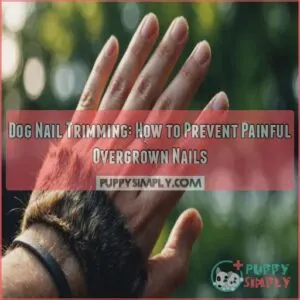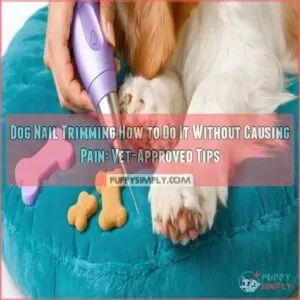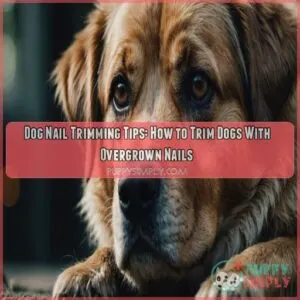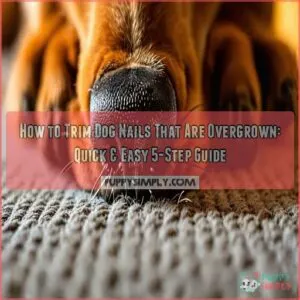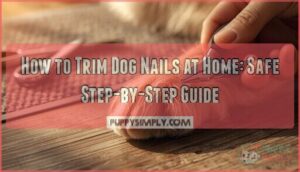This site is supported by our readers. We may earn a commission, at no cost to you, if you purchase through links.
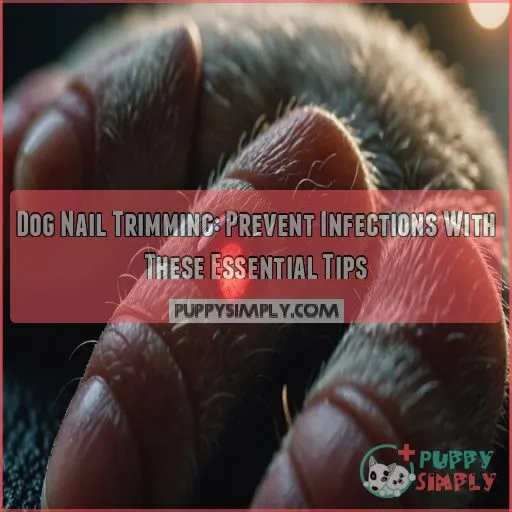
Be sure to wash your hands before trimming to keep things squeaky clean and avoid turning a small snip into a big problem.
Selecting the right clippers based on your dog’s needs is important too. Oh, and skipping rewards is a no-go! Treats make trimming a positive experience. Discover more tips in the full guide.
Table Of Contents
- Key Takeaways
- Importance of Cleanliness
- Choosing the Right Clippers
- Preparing Your Dog
- Trimming Techniques
- Preventing Infection
- Common Mistakes to Avoid
- Aftercare and Maintenance
- Recognizing Signs of Infection
- Seeking Veterinary Care
- Frequently Asked Questions (FAQs)
- How to keep a dog’s nail from getting infected?
- How do you prevent a dog’s broken nail from getting infected?
- Can a dog get an infection from cutting nails?
- How do you prevent bacterial skin infections in dogs?
- How often should dog nails be trimmed?
- Can nail infections spread to other dogs?
- What are natural remedies for nail infections?
- Are certain dog breeds more prone to infections?
- Do diet supplements help prevent nail issues?
- Conclusion
Key Takeaways
- Keep all your tools and paws squeaky clean. Wash your dog’s paws after trimming, disinfect those clippers as if they’re going on a first date, and don’t forget to wash your hands – it’s your first line of defense against bacterial invasions.
- Choose the right clippers for your canine buddy’s nail type, whether they’re thick, thin, or attached to a sensitive pooch. It’s like picking the right shoes for a marathon – comfort and precision count.
- Build a comforting nail trimming routine for your dog. Use positive reinforcement – treats, praise, and maybe a side of belly rubs – to make nail time a walk in the park, not a wrestling match.
- Stay alert for any signs of infection, such as redness, swelling, or a foul odor. Catch symptoms early – because playing detective is fun, but keeping a vet on speed dial is even better for your pup’s health.
Importance of Cleanliness
To keep those wagging tails happy, it’s really important you pay close attention to the cleanliness of your dog’s nail trimming routine, especially when learning about dog nail anatomy.
This means keeping the nail area clean, disinfecting your tools, and washing your hands—because no pup wants paws that play host to little bacteria parties!
Keeping the Nail Area Clean
Keeping your pup’s paws squeaky clean is really important.
Give those tootsies a thorough wash with warm water and pet-safe soap after each trim.
Don’t forget to dry them off completely – damp nails are an open invitation for bacteria to party.
Disinfecting the Nail Clippers
You wouldn’t cook dinner with a dirty spoon, so don’t tackle dog nail trimming with grimy clippers and be sure to clean your tools properly.
Sanitation is your armor against bacterial infections.
Sterilize those nail clippers like they’re going on a first date—shine ’em up! A simple swipe with alcohol can boost hygiene, ensuring safety and cleanliness.
Washing Your Hands Before Trimming
Before you start dog nail trimming, think of your hands as a superhero’s shield against the villains of bacteria, but learn how to trim your dog’s nails without causing anxiety! Hand hygiene reduces infection risk.
Follow these steps:
- Wash with soap and water.
- Use a clean towel to dry.
- Avoid touching dirty surfaces.
- Don’t rush—dog safety first!
Choosing the Right Clippers
To keep your dog’s nails healthy and free from infections, choosing the right clippers is essential.
Whether they’re thick, thin, or attached to a sensitive pooch, using the wrong clippers is like trying to cut steak with a butter knife—it just doesn’t work!
Selecting Clippers Based on Nail Type
When choosing clippers, consider your dog’s nail type.
If you’re dealing with dog nail overgrowth or preventing dog nail injury, balance clipper size and blade sharpness.
Opt for a grip that feels like a handshake, not a wrestling match!
Clippers for Thick Nails
For those hefty dog nails that resemble more of a lumberjack’s task, opt for clippers specifically designed for thick nails.
Brands like Safari and Epica offer sturdy options, ensuring you don’t get stuck mid-trim.
Think of it as nail grinding for logs!
Clippers for Thin Nails
Finding the perfect clippers for thin nails can be like a needle in a haystack.
Consider these options:
- Scissor-type clippers for precision.
- Guillotine clippers for ease.
- Popular clipper brands like Dremel.
- DIY solutions for manageable at-home trimming.
Clippers for Sensitive Dogs
Sensitive pups deserve extra TLC.
Look for clippers with soft, rounded edges to minimize discomfort.
Pair with positive reinforcement and go slow – your dog will thank you for the gentle approach.
Preparing Your Dog
Before you start clipping your dog’s nails, it’s really important to make them comfortable with the process; otherwise, you’ll end up wrestling a squirmy pup instead of trimming claws.
Spend some time introducing the clippers to your dog and reward their cooperation—you’ll both be happier for it!
Getting Your Dog Used to the Clippers
After picking the perfect clippers, it’s all about getting your dog familiar with them.
Dogs love routine, so make nail trimming a fun experience.
Use positive reinforcement, and gradual introduction, to boost your pup’s comfort and maintain dog health!
Desensitizing Your Dog to the Trimming Process
Gently introduce trimming by showing clippers without using them.
Let your dog sniff them, then gradually move closer.
Use positive reinforcement to associate clippers with good things.
Patience and consistency are key in reducing anxiety about nail treatment.
Rewarding Good Behavior
Reward your pup’s good behavior during nail trims with tasty treats, enthusiastic praise, or a favorite toy.
This positive reinforcement helps build trust and makes the process more enjoyable for both of you.
Calming Your Dog During Trimming
Maintaining positive reinforcement, start by creating a stress-reducing environment for dog nail trimming.
Think calming treats or desensitization techniques.
Gentle handling works wonders when calming your dog, reducing stress linked to bacterial infections.
Your dog’s safety matters most—happy trails, not tails!
Trimming Techniques
When trimming your dog’s nails, aim to avoid the dreaded quick—it’s like finding Waldo, but with a little more pressure!
Use an angled cut to keep things smooth, and your dog will be thanking you with every wag.
Trimming the Quick Safely
Once your dog feels comfortable, gently identify the quick by its pink hue.
Be cautious trimming here to prevent quick bleeding.
Use sharp nail trimming tools or a grinder to avoid bacterial infections.
Keep an eye on your dog’s reaction.
Avoiding Cutting the Quick
To avoid cutting the quick, look for the pink vein running through the nail and stop trimming just before reaching it. Take small, careful snips to be safe.
Identify the quick – the pink vein inside the nail.
- Identify the quick – the pink vein inside the nail.
- Trim slowly and cautiously, stopping just before the quick.
- Use a bright light to clearly see the nail’s anatomy.
Trimming the Nail at an Angle
With nail trimming, angle is king.
By cutting your dog’s nails at an angle, you avoid quick exposure and improve nail shape.
This precision helps fend off nail infections.
It might feel awkward, but avoiding infections is worth a cat’s curiosity!
Smoothing the Edges
After clipping, grab a nail file and smooth those edges.
It’s like a spa day for your canine!
This extra step in dog nail care helps prevent splinters and keeps nails tidy.
Who knew nail filing could be so paw-some?
Preventing Infection
To keep your furry friend’s nails free from infections, a few simple precautions can make all the difference.
Learn how to apply antibiotic ointment, use a styptic powder if needed, and remember to keep those paws dry—because no dog likes soggy feet!
Applying Antibiotic Ointment
After trimming, apply a thin layer of antibiotic ointment to the nail to prevent infection.
This helps soothe the area and ward off nasty bacteria.
Reapply as directed for best results.
Using a Styptic Powder
Apply a thin layer of antibiotic ointment after trimming to help prevent infections.
Styptic powder‘s your go-to for stopping any bleeding from a quicked nail.
It’s quick, easy, and keeps your pup’s paws ready for action!
Monitoring for Signs of Infection
Always keep an eye out for nail discoloration or toe swelling.
If your pup’s paw licking becomes excessive, nail sensitivity increases, or you spot pus discharge, that’s a red flag.
It’s time to fetch your vet and tackle it pronto!
Keeping the Nail Area Dry
Don’t let wet paws be a dog’s rainstorm.
Use water-resistant nail balms and waterproof paw boots to keep them dry.
Develop a paw drying routine with towel techniques or air-drying after baths to prevent infections from developing.
Common Mistakes to Avoid
Trimming your dog’s nails can be tricky, and common mistakes like cutting them too short or not disinfecting the clippers can lead to painful infections.
Avoid these pitfalls by following our expert tips to keep your pup’s paws healthy and happy.
Cutting the Nail Too Short
Sure, it’s tempting to trim a little extra, but cutting too short risks quick exposure, leading to bleeding and pain for your pup.
Nail growth needs precision to minimize infection risk.
Who knew a tiny quick could cause so much drama?
Not Disinfecting the Clippers
Clippers and germs go hand in hand if you’re not careful!
Nail clipper hygiene‘s a breeze—just like flossing.
Don’t skip sterilization before each use to prevent bacteria transmission.
Cleanliness is key to keep infections at bay and your dog healthy.
Not Rewarding Good Behavior
Forgot to clean those clippers? Well, don’t also forget that rewarding good behavior is like giving your dog a treat for their soul.
A sprinkle of positive reinforcement motivates your dog, making future nail trims a walk in the park!
Trimming Too Frequently
Trimming your pup’s nails too often can actually do more harm than good.
Overdoing it can lead to painful quicks and make your canine companion dread nail time.
Stick to a regular schedule to keep those talons in tip-top shape.
Aftercare and Maintenance
Regular nail trims aren’t just for looks—they’re really important for your dog’s health, too, and can help prevent infections.
Keep those nails in tip-top shape with a soothing nail balm and a consistent trimming schedule, much like a manicure for a pampered pup!
Applying a Nail Balm
After avoiding common trimming mistakes, give your dog’s nails some TLC with a soothing nail balm. It’s like a spa day for paws!
Applying a nail balm can:
- Moisturize and protect from cracking.
- Include ingredients like beeswax for a smooth finish.
- Be applied after each trim for lasting benefits.
- Help combat dryness with regular use.
- Be found in various dog-friendly brands.
Scheduling Regular Trims
Keeping your dog’s nails in tip-top shape is as easy as pie when you schedule regular trims. Instead of playing "catch-up," a consistent routine helps you sidestep any nail woes.
Here’s a quick guide:
| Factor | Frequency |
|---|---|
| Age | Every 2-4 weeks |
| Breed | Check monthly |
| Lifestyle | Active: Bi-weekly |
| Cost | Budget accordingly |
Regular trims keep infections at bay, ensuring both you and your furry friend walk on sunshine.
Recognizing Signs of Infection
Keeping an eye out for signs of infection is very important after trimming your dog’s nails.
Look for redness, swelling, discharge, foul odor, or limping – these could indicate a problem that needs your vet’s attention.
Redness and Swelling
Notice redness and swelling? Your dog might be hinting at a nail infection. Regular nail care helps, but sometimes infections sneak in.
Here are signs to watch for:
- Redness around the nails
- Swelling of the toes
- Discomfort when touched
- Unusual nail color
Discharge or Pus
Spot the warning signs—discharge or pus oozing from your dog’s nail.
Keep an eye on pus color, consistency, location, and amount.
Think of your pup’s nail as a detective story, revealing clues to their health mystery.
Always consult your vet.
Foul Odor
If you catch a whiff of a foul odor from your dog’s paw, it may signal an infection risk.
Proper nail hygiene is your first line of defense.
Home remedies might help, but don’t skip veterinary care for persistent issues.
Limping or Favoring the Paw
Your dog limping or favoring a paw could signal a painful nail infection. Check for swelling, redness, and any discharge – these are red flags requiring a vet visit to prevent complications.
Seeking Veterinary Care
If your dog’s nails are showing signs of serious infection, like persistent swelling or a foul odor, it’s time to get to the vet’s ASAP.
Don’t wait—acting quickly can make all the difference in keeping your furry friend comfortable and on all four paws!
When to Seek Immediate Attention
Your furry friend might need a vet visit if he’s limping or excessively licking his paw.
Notice any pus discharge or nail discoloration?
Severe swelling or consistent doggy misery signals a need for professional help faster than you can say "woof!
Signs of a Severe Infection
When nail problems lead you to raise an eyebrow or two, you might notice troubling signs:
- Nail bed swelling and limp like a cowboy in high heels.
- Pus discharge with a side of fever.
- Loss of appetite.
Treatment Options for Infections
If your dog’s nail infection is severe, your vet may prescribe oral antibiotics or recommend IV treatment.
Home remedies like Epsom salt soaks can help, but see the vet if symptoms persist or worsen.
Preventing Future Infections
After treating infections, preventing future ones is key.
Establish a nail care routine to enhance dog nail hygiene.
Choose the right clipper types, minimizing infection risks.
Use home remedies like trims and ointments.
Keep paws pristine, avoiding recurrent infections.
Frequently Asked Questions (FAQs)
How to keep a dog’s nail from getting infected?
To keep your dog’s nails from getting infected, trim them regularly, clean their paws often, and watch for any signs of injury or irritation. (Source)
How do you prevent a dog’s broken nail from getting infected?
Did you know 20% of dog injuries involve nails?
Keep Fido’s broken nail clean, dry, and covered.
Use antiseptic and a soft bandage; swap stories with your vet about wild adventures to make sure proper healing happens.
Keep tails wagging!
Can a dog get an infection from cutting nails?
Cutting your dog’s nails can indeed lead to infections if the quick gets nicked.
Make sure you don’t cut too deeply and keep cuts clean.
If you spot redness or swelling, see your vet pronto!
How do you prevent bacterial skin infections in dogs?
An ounce of prevention beats a pound of cure! Keep your dog’s skin clean and dry, regularly bathe them, and promptly treat wounds. Boost their immune system with a balanced diet and regular vet check-ups.
How often should dog nails be trimmed?
Most dogs need their nails trimmed every 2-4 weeks to prevent overgrowth and discomfort, as recommended by puppysimply.com.
Pay close attention to your pup’s nails and trim them regularly to keep them healthy and happy.
Can nail infections spread to other dogs?
Contagion isn’t as trendy among dogs as humans might fear.
Still, nail infections spread primarily through direct contact or shared grooming tools.
Keep Fido’s paws clean and trimmed to limit infectious mingling at the dog park.
What are natural remedies for nail infections?
Consider soaking your pup’s paw in warm water with a dash of Epsom salt for relief.
Chamomile tea soaks can also soothe inflammation.
Just remember, these remedies aren’t a substitute for professional advice—when in doubt, call your vet!
Are certain dog breeds more prone to infections?
Visualize this: Some dog breeds like Dalmatians, Boxers, and Greyhounds are infection magnets when it comes to nail issues due to their predisposition for specific conditions.
Understanding your dog’s breed helps nip these infections in the bud (Source).
Do diet supplements help prevent nail issues?
Yes, diet supplements containing key nutrients like biotin, omega-3s, and amino acids can help strengthen your dog’s nails and prevent issues like brittleness, splitting, and infections.
Conclusion
Wrapping up the dog nail trimming saga, remember, an ounce of prevention is worth a pound of cure.
By maintaining cleanliness, choosing the right tools, and rewarding your pup, you’ll easily prevent bacterial infections.
Stay vigilant about any signs of trouble, like redness or limping, and don’t hesitate to seek professional help if needed.
Making nail care a positive, stress-free routine will help your furry friend be comfortable and healthy. Keep their paws happy and infection-free!

